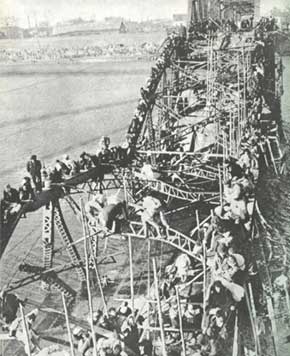HOME



Short History of the Divided Families
There are four groups of divided families: The first were separated right after World War II in Manchuria,
the second were separated during the Korean War, the third were Korean War POWs, and the fourth were civilians taken to North Korea by force
during the war.
Group 1

Donhwa train station in Manchuria, where thousands of families became separated right after World War II (photo from Google maps)
During the 36 years of Japanese occupation of the Korean peninsula, a lot of young men left their homeland and went to Manchuria in order not to be forced into the Japanese army. Some joined the Korean guerrillas, some joined the group of people transforming wild land in Manchuria into agricultural land, and some started their own businesses. When World War II was over, and Korea became independent from Japan, the border between China and North Korea was closed so quickly that a lot of men became trapped in Manchuria and some family members who were left behind became separated from the family members who had already left for South Korea. Eventually, these men moved to North Korea, but they were trapped in North Korea again for various reasons and became separated from their family members in South Korea.
Group 2

Refugees crossing the bridge during the Korean War
The majority of the divided families belong to the second group.
During the Korean War, boys who were 11 years old or older and young men left their parents and siblings in North Korea in order not to be conscripted into the North Korean army.
A lot of married men left their wives and children in North Korea, and married women left their parents and siblings in North Korea when they came to the south with their husbands.
Some left North Korea without their married sons and daughters, and some parents left their daughters to take care of their grandparents who couldn’t travel south on foot.
They all thought the separation would be temporary, and nobody ever thought they would never see their family members again.
Many separations happened on the way to the South.
Millions of people walked to the South, and adults carried their belongings, and a lot of women carried babies on their backs.
In the chaotic situation when they pulled and pushed, and ran for the shelters, or crossed the rivers or tried to get to the boats in the deep, rough cold water,
and when the boats suddenly took off, separations happened.
Group 3

The third group were Korean War POWs. According to Lieutenant Chang Ho Cho, who escaped from North Korea in 1994,
there were about 500 POWs in North Korea. Since then, 60 POWs have escaped from North Korea,
and 30 of these former prisoners have returned to South Korea.
Hwang Yong Kim from Voice of America in Seoul reported that a former Korean War POW succeeded in escaping from North Korea
after 55 years. In July 1953, right before the Korean War truce began,
he was wounded and captured by the North Korean army in Kang Won Province.
He is 74 years old and uses the fake name. He is in extremely poor health.
Presently he is staying in China, and he is anxious to go home to South Korea.
In the case of Navy Sergeant Do (See the Stories of Divided Families),
he was kidnapped by the North Koreans during the fight between North and South Korean battleships in the Western Sea in 1970.
The teenage POWs in North Korea would be in their late 80’s now if they are still alive.
Group 4
The fourth group were South Korean civilians including scholars, medical doctors, engineers, scientists, and specialists in various fields. They were taken to North Korea by force during the Korean War, and the Korean government has a list of 96,013 names of civilians taken to North Korea. However, this group also remains problematic because North Korea claims that they came to North Korea on their own, and therefore, they are not divided families.
(Link to Annabel Park’s letter)
All this happened almost 60 years ago, and since then time and places have changed. Most of us have lived in the United States for more than 30 years, and now we are proud to be Americans. But we have lived with black holes in our hearts. The divided family members are now in their upper 70's, 80's, and 90's, and most people We knew 10 years ago have passed away. There are not hundreds of or even tens of thousands of divided family members left any more. We have only thousands of them at most left, and we are losing them very fast. Time is running out for us!

